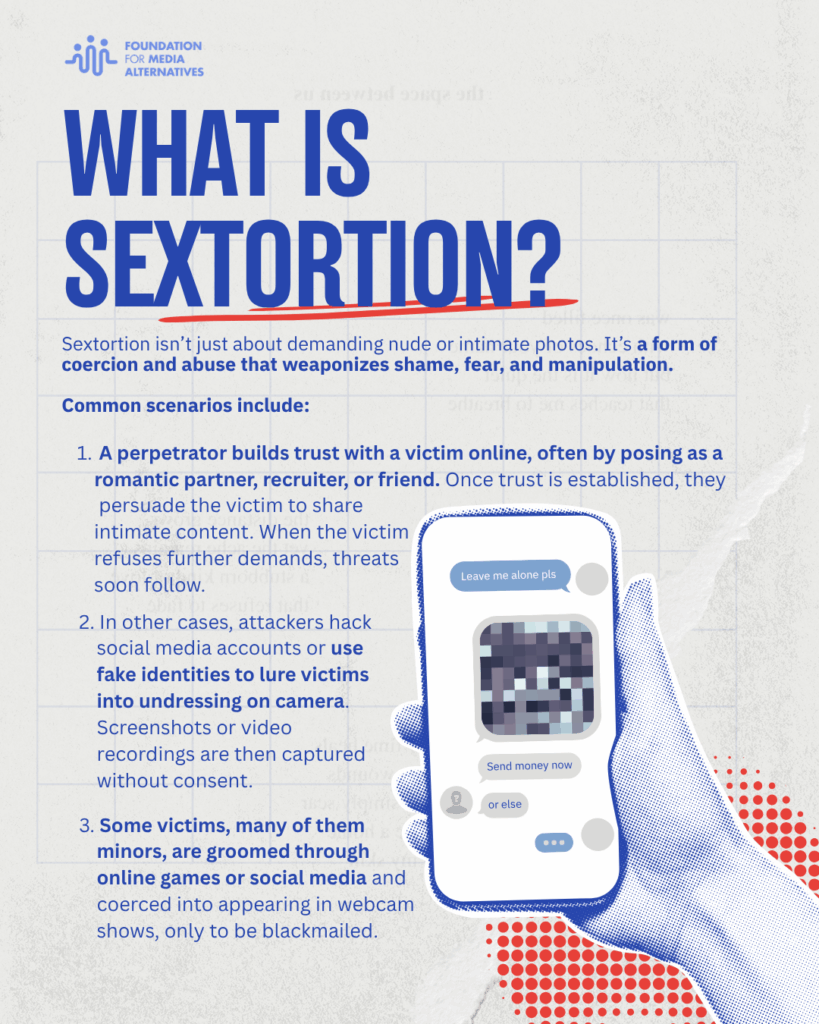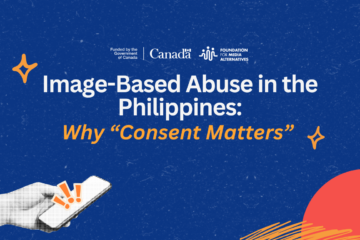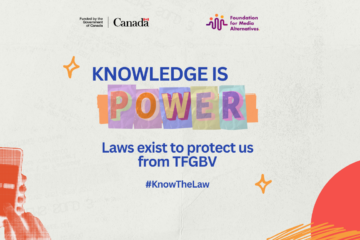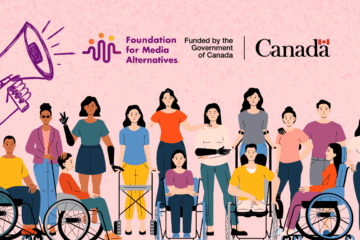Sextortion in the Philippines: The Hidden Crisis Behind Screens

In a country where over 97 million individuals are connected to the internet, the digital platforms have become more than just tools for connection, they are now a vital part of everyday life. But beneath the ease and entertainment they offer lies a growing danger: sextortion, a disturbing and often hidden form of online abuse that increasingly targets Filipinos, particularly young women, girls, and LGBTQ+ individuals.
Sextortion, a term that merges “sex” and “extortion”, involves the use of threats to share intimate images, videos, or personal information unless the victim complies with demands, which often include sending more explicit content, money, or sexual favors.
This form of abuse violates human dignity, invades privacy, and threatens personal safety. In the Philippines, cases are alarmingly on the rise.
What Is Sextortion?
Sextortion isn’t just about demanding nude or intimate photos—it’s a form of coercion and abuse that weaponizes shame, fear, and manipulation.
Common scenarios include:
- A perpetrator builds trust with a victim online, often by posing as a romantic partner, recruiter, or friend. Once trust is established, they persuade the victim to share intimate content. When the victim refuses further demands, threats soon follow.
- In other cases, attackers hack social media accounts or use fake identities to lure victims into undressing on camera. Screenshots or video recordings are then captured without consent.
- Some victims, many of them minors, are groomed through online games or social media and coerced into appearing in webcam shows, only to be blackmailed repeatedly.
These threats often include demands such as:
- Sending additional explicit content or performing sexual acts,
- Transferring money through e-wallets, online banking, or cryptocurrency,
- Or even sharing intimate material with the victim’s family or social circles as a form of pressure.
Whether the abuser is a stranger, a classmate, or a former partner, the emotional toll is real, lasting, and deeply traumatic.
Sextortion in the Philippine Context
The Philippines faces distinct and growing risks when it comes to sextortion. As one of the most active social media populations in the world, many young Filipinos spend significant time online often through smartphones yet lack access to adequate digital literacy, privacy protections or safety tools.
Cultural values such as modesty, family reputation, and hiya (shame) can further discourage victims from coming forward. This silence is compounded by systemic challenges: while law enforcement agencies have taken steps to address cybercrime, they continue to face limited resources, training, and capacity to fully respond to online gender-based abuse.
Units such as the Philippine National Police and the National Bureau of Investigation receive hundreds of sextortion complaints each year. However, the real number is likely much higher, with many cases remaining unreported and undocumented.
Filipino women and LGBTQ+ individuals face heightened vulnerability, not only due to digital exposure but also because of deep-rooted patriarchal norms that enable harassment, stigma, and impunity in both online and offline spaces.
Red flags and tactics used by the perpetrators
Perpetrators often use tactics like creating fake profiles, either posing as a classmate, recruiter, or attractive stranger, to build trust and get close quickly. Some use “love bombing” or grooming, showering victims with attention, compliments, or small gifts to lower their guard. They may ask for “just one” private photo or video, making it seem harmless at first. But once they have something compromising, they often record video calls without consent or take screenshots secretly. Then come the threats and emotional manipulation, saying things like, “If you don’t send more, I’ll post this on Facebook,” or “I’ll message your parents,” or demanding money with threats like, “This goes viral unless you pay ₱5,000 now.” These tactics are meant to create fear and control, but knowing them is the first step to fighting back.
Psychological Impact on Victims
Sextortion can leave deep and lasting emotional scars. Many victims experience severe anxiety, panic attacks, depression, and even suicidal thoughts. They may live in constant fear of being seen, judged, or exposed, leading to isolation and difficulty trusting others. Shame and self-blame are also common, even though the abuse was never their fault.
For young people, especially teenagers, this kind of trauma can disrupt their studies, damage friendships, and affect how they build relationships in the future.
What to do if you are a victim
If you or someone you know is experiencing or has experienced sextortion, it’s important to act promptly. First, do not respond to the abuser or comply with their demands. Do not pay. Do not send more photos. Most importantly, do not negotiate, as this can make things worse. Instead, document everything: take screenshots of messages, threats, usernames, payment requests, and any URLs. Save your chat logs and media files, but avoid deleting anything too soon, as it could be used as evidence. Next, secure your accounts by changing all your passwords, enabling two-factor authentication, logging out of all devices, and making sure your passwords are strong and unique. Most importantly, report the crime to the proper authorities.
Seek Emotional Support
Remember that you are not alone. Help is available. You can speak with a counselor, reach out to a trusted adult, or contact a local support group. For emotional and mental health support, the National Center for Mental Health Crisis Hotline is open 24/7 at 1553 and is free to call. You can also reach out to organizations like the Foundation for Media Alternatives via info@fma.ph or www.fma.ph, the Women’s Legal and Human Rights Bureau at womenslegalbureau@protonmail.com, and the Lunas Collective, which offers compassionate chat-based support at https://lunascollective.org/contact.
For immediate concerns, you may call the PNP Anti-Cybercrime Group at (02) 8414-1560 or the NBI Cybercrime Division at (02) 8523-8231 local 3454.
You don’t have to go through this alone. There are people and communities ready to listen and support you.
Prevention: Protect Yourself and Others
While the blame for sextortion always lies with the abuser, there are ways we can protect ourselves and others through safer digital habits. Avoid sharing intimate content online, even with people you trust, because it can easily be misused. Be cautious if someone you just met online gets intimate too quickly. Simple actions like covering your webcam when it’s not in use can also help protect your privacy.
Most importantly, for others, talk openly with your children, students, and peers about online consent and digital safety. Always remember: never blame the victim. Shame only silences survivors and silence protects abusers.
Fighting Back: What Needs to Change
Addressing sextortion in the Philippines requires more than just raising awareness. It is high time for concrete, systemic change. We need stronger and more consistent enforcement of laws on violence against women and children, as well as cybercrime, to ensure perpetrators are held swiftly and fully accountable. Digital literacy must be integrated into schools and community programs so people, especially the youth, can better protect themselves online.
Equally important are support systems that reject victim-blaming and instead center survivors’ voices with compassion and care. Reporting mechanisms must be safe, accessible, and survivor-centered. Technology companies also have a critical role to play: they must take proactive steps to detect, report, and remove harmful content before it escalates.
Ending sextortion means building a digital ecosystem where safety, dignity, and justice are not the exception—but the norm.



0 Comments